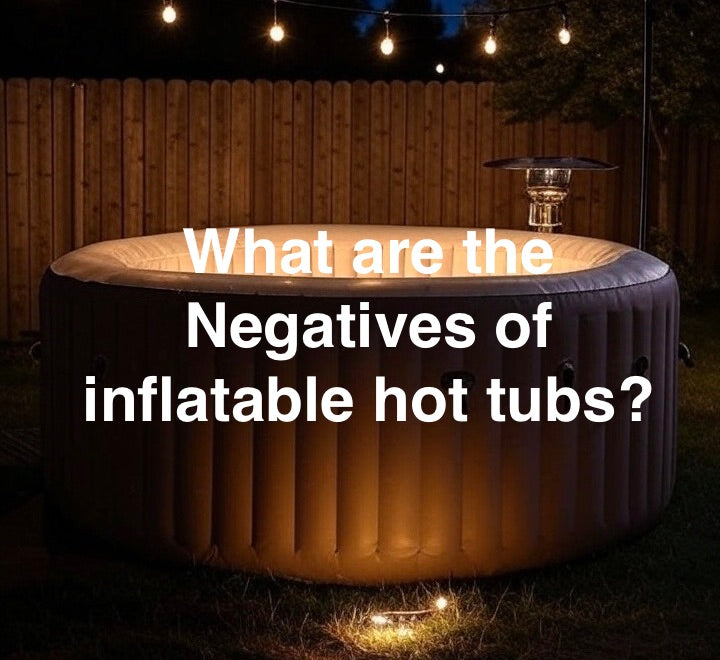
What are the Negatives of Inflatable Hot Tubs?
Thinking of jumping into inflatable spas for family fun?
Short answer: they’re cheap thrills but come with hidden hassles—think leaky seams, chilly dips, and weaker bubbles. Stick around as we reveal the not-so-glam side of inflatable hot tubs, so you can decide if they’re really worth it.

Performance and Efficiency Problems
Slow and Costly to Heat
One of the biggest complaints about inflatable hot tubs is how painfully slow they are to heat up. We’re talking about just 1–3 degrees per hour. So if your water starts off cold, you might be waiting an entire day before it’s ready.
On top of that, they’re energy-hungry. Families often discover that keeping the water hot quickly racks up the electricity bill. And if you’re hoping for a spontaneous evening soak after a long day, waiting 24 hours for warm water can be a real mood killer.
Poor Heat Retention
Even once you’ve got the water nice and toasty, keeping it that way is another battle. Inflatable tubs are made from thin vinyl or PVC, which offers little insulation. As soon as the cover’s off or the temperature outside dips, the heat disappears faster than a packet of biscuits at a kids’ party.
This means the heater has to work overtime, costing you even more. Not great news if you’re dreaming of year-round relaxation in unpredictable British weather.
Weak Jets and Limited Hydrotherapy
Many people buy a hot tub for the therapeutic benefits—the powerful jets that massage away tension. Unfortunately, most inflatable hot tubs can’t deliver this.
What they call “jets” are usually just air blowers, creating bubbles rather than targeted streams of water. Fun for the kids? Absolutely. But if you’re looking for muscle relief after a long week, you might find yourself disappointed.
Inadequate Filtration and Water Quality
Another headache is keeping the water clean. Inflatable tubs use small, easily clogged filters. With heavy family use, they often struggle to keep up, meaning the water can go cloudy surprisingly quickly.
That means more time testing, treating, and changing the water. Parents juggling work, kids, and everything else may find this extra upkeep more of a chore than a chill-out session.
Durability and Longevity Issues
Prone to Punctures and Leaks
Here’s the obvious one—punctures. Whether it’s a dog bounding past with sharp claws, a child’s toy dropped inside, or simply setting it up on a rough patch of patio, inflatable hot tubs aren’t built to take much punishment.
Even without accidents, air loss over time is common. It’s hard to fully relax when you’re constantly checking for leaks.
Short Lifespan Compared to Hard-Shell Spas
A traditional hot tub can last a decade or more with proper care. Inflatable hot tubs? You’re often looking at 2–5 years at best.
For families hoping for a long-term investment, that short lifespan can turn what looked like a cheap option into an expensive cycle of replacements.
Difficult and Expensive Repairs
To make matters trickier, repairing an inflatable spa isn’t always straightforward. The heaters and pumps tend to be proprietary, meaning they’re hard to source and costly when something breaks.
Unlike hard-shell models, where parts are widely available and replaceable, inflatables often end up being more disposable. Once something fails, replacing the whole unit is sometimes the only option.
Comfort and User Experience Drawbacks

Cramped and Misleading Capacity
Hot tubs are often advertised as “four-seaters” or “six-seaters.” But with an inflatable, that usually means four adults squeezed in like sardines, knees knocking together. The thick walls eat into the internal space, leaving less room than you’d expect.
For families, it’s fine for a quick dip with the kids, but don’t expect to host a relaxing soak with friends unless you enjoy sitting in very close quarters.
Lack of Ergonomic Seating
Another common frustration is the lack of proper seating. In an inflatable, you’re sitting directly on the floor of the tub. That can feel fine at first, but after 20 minutes your back might tell a different story.
Getting in and out can also be awkward, especially for grandparents or anyone with mobility struggles. It’s far from the easy, spa-like experience many people picture.
Can Be Loud
Then there’s the noise. Those bubble blowers that make the tub look fun? They can be surprisingly loud. Instead of a peaceful soak under the stars, you may find yourself shouting over the hum of the motor.
It’s worth considering if your idea of relaxation includes actual peace and quiet.
Weather and Placement Limitations
Finally, inflatable hot tubs aren’t suited to all-weather use. Most aren’t recommended below 7–10°C, which makes them less appealing during our long British winters.
They’re also heavy when filled, so not suitable for balconies or raised decking. Placement options are limited, and for many families, that can be a deal-breaker.
Conclusion: Are Inflatable Hot Tubs Worth It?

Inflatable spas can be a fun, affordable way to dip your toes into hot tub ownership. They’re easy to set up and can provide hours of splashing around with the kids.
But when you factor in the running costs, durability issues, and comfort limitations, they’re not the long-term relaxation solution many families are hoping for. If you’re serious about regular hot tub use, investing in a sturdier, hard-shell model may save you time, money, and hassle in the long run.
Have you checked out our other posts?
What Are The Downsides Of Inflatable Hot Tubs?
Do You Sit On The Floor With An Inflatable Hot Tub?
How Long Do Inflatable Hot Tubs Usually Last?
What Is The Life Expectancy Of An Inflatable Hot Tub?
Do Inflatable Hot Tubs Puncture Easily?
How Often Should I Change My Inflatable Hot Tub Filter?
What Is The Best Thing To Clean The Inside Of An Inflatable Hot Tub?
Are Inflatable Hot Tubs A Lot Of Maintenance?
Should You Leave An Inflatable Hot Tub On All The Time?
Are Inflatable Hot Tubs Durable?



Leave a comment